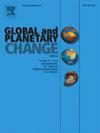Holocene dust storms and their driving mechanisms on the northeastern Tibetan Plateau
IF 4
1区 地球科学
Q1 GEOGRAPHY, PHYSICAL
引用次数: 0
Abstract
The Tibetan Plateau (TP) is an important dust source region, where frequent dust storms substantially impact the regional ecological environment and even the global climate system. However, the driving mechanisms of dust storms on the northeastern TP during the Holocene are unclear due to the scarcity of geological archives. In this study, a sediment core from Koucha Lake on the northeastern TP was analyzed for grain size, geochemical elements, along with total organic carbon (TOC) and total nitrogen (TN), to infer the Holocene dust storm history and explore the likely driving mechanisms. Our findings indicate that during the late Holocene, especially after 6.9 cal ka BP, dust storm activity intensified with significant fluctuations, reaching a peak after 5 cal ka BP. Notably, our comparison with other climatic environmental records reveals that the pattern of dust storm enhancement during the Holocene diverges from the prevailing trend of increasing moisture availability and vegetation cover, suggesting that these factors may play a limited role in modulating dust storms on the northeastern TP. Instead, the enhancement of dust storms on the northeastern TP during the late Holocene is closely associated with the southward shift of the westerly jet. By revealing dust storm evolution and its mechanisms on the northeastern TP, our study provides a scientific basis for forecasting the future dust storm changes and developing regionally targeted dust mitigation strategies.
青藏高原东北部全新世沙尘暴及其驱动机制
青藏高原是重要的沙尘源区,频繁发生的沙尘暴对区域生态环境乃至全球气候系统产生重大影响。然而,由于地质资料的缺乏,全新世青藏高原东北部沙尘暴的驱动机制尚不清楚。本文通过对青藏高原东北部库车湖沉积物岩心的粒度、地球化学元素、总有机碳(TOC)和总氮(TN)进行分析,推断全新世沙尘暴的历史,并探讨其可能的驱动机制。研究结果表明,在全新世晚期,特别是在6.9 cal ka BP之后,沙尘暴活动加剧且波动显著,在5 cal ka BP之后达到峰值。值得注意的是,我们与其他气候环境记录的比较发现,全新世沙尘暴增强的模式与水汽有效性和植被覆盖增加的主流趋势不同,表明这些因素可能对东北地区的沙尘暴起有限的调节作用。晚全新世青藏高原东北部沙尘暴的增强与西风急流的南移密切相关。通过揭示东北高原沙尘暴演变及其机制,为预测未来沙尘暴变化和制定有针对性的区域降尘策略提供科学依据。
本文章由计算机程序翻译,如有差异,请以英文原文为准。
求助全文
约1分钟内获得全文
求助全文
来源期刊

Global and Planetary Change
地学天文-地球科学综合
CiteScore
7.40
自引率
10.30%
发文量
226
审稿时长
63 days
期刊介绍:
The objective of the journal Global and Planetary Change is to provide a multi-disciplinary overview of the processes taking place in the Earth System and involved in planetary change over time. The journal focuses on records of the past and current state of the earth system, and future scenarios , and their link to global environmental change. Regional or process-oriented studies are welcome if they discuss global implications. Topics include, but are not limited to, changes in the dynamics and composition of the atmosphere, oceans and cryosphere, as well as climate change, sea level variation, observations/modelling of Earth processes from deep to (near-)surface and their coupling, global ecology, biogeography and the resilience/thresholds in ecosystems.
Key criteria for the consideration of manuscripts are (a) the relevance for the global scientific community and/or (b) the wider implications for global scale problems, preferably combined with (c) having a significance beyond a single discipline. A clear focus on key processes associated with planetary scale change is strongly encouraged.
Manuscripts can be submitted as either research contributions or as a review article. Every effort should be made towards the presentation of research outcomes in an understandable way for a broad readership.
 求助内容:
求助内容: 应助结果提醒方式:
应助结果提醒方式:


